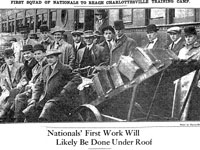 |
|
The 1912 Nationals exit a train. Photo courtesy of The Washington Post. |
(Editor’s Note: this article originally ran on March 8, 2012 as a Sabre Edge feature, but is re-presented here as a free article for all to enjoy.)
Yes, Wahoo fans: “The University of Virginia” and “major league spring training” can be used in the same sentence for ’12 and ’13.
In a story that received shockingly little media coverage, The Washington Post announced to the surprise of Washington D.C. baseball fans and Charlottesville residents that “the home selected for the Nationals is just outside of the university grounds and within a stone’s throw of the campus.”
“If the Washington manager … shows the same get up and hustle in handling the Nationals the coming season that he did in completing arrangements for a training camp,” the article continues, “… Washington will have little cause to complain. It is ideally located, and was at first constructed for a private dwelling. Electric cars pass in front of the door giving easy access to the city and to Fry’s Springs, the local summer resort, where splendid mineral waters are to be had – and be it remembered, Charlottesville is a dry town.”
Electric cars? Fry’s Springs summer resort? Charlottesville a dry town? If this doesn’t sound like the Charlottesville you know, perhaps it would help to clarify that the ’12 and ’13 spring training accommodations refer to 1912 and 1913. One hundred years ago this March, the Washington Nationals – who also went by the nickname “Senators” from 1905-55 – were gearing up to spend three weeks in the “hamlet” of Charlottesville, working out at the UVa facilities to prepare their baseball nine for the upcoming season.
The Washington Post described the scene on January 23, 1912: “A walk of two squares will take the players to the gymnasium, which is on the brow of a hill overlooking Lambeth field, the training ground. A large boarding house is next door, and the players will have but a few steps to go get their meals.”
The Old Fox
The Nationals/Senators manager was Clark Griffith, nicknamed “The Old Fox.” He pitched for the St. Louis Browns and Boston Reds in 1891. He was a crafty player, known to doctor his pitches with spitballs, scuffed or cut balls, and even claimed to have invented the screwball. His first managing gig was in 1903 for the New York Highlanders. In 1912 he became the manager for the Senators – who relocated in 1961 and eventually became the Minnesota Twins – where he led one of the largest turnarounds in baseball history. Despite being retired as a player, he occasionally pitched a few innings for the Senators from 1912-14.
As a 10-percent owner of the Senators, Griffith ran the team on a tight budget. He wanted cheap accommodations, low travel costs, and high quality facilities for his contingent; Charlottesville provided the perfect combination.
Spring Training Gets Sprung
Spring training at the turn of the 20th century did not compare to today’s highly organized, Grapefruit and Cactus Leagues that transport players to more temperate climates in order to prepare for their upcoming campaigns. With the advent of the first professional baseball league in 1871 most teams trained on the grounds where they would compete during the season. It wasn’t until the 1890s that major league teams sought new sites in which to find better weather and fewer distractions. The Philadelphia Phillies were the first of today’s major league teams to train in Florida when they traveled to Jacksonville in 1888.
In fact, the University of Virginia’s Grounds had been home to spring training for several professional teams beginning as far back as 1890, when a four-year project to level out the playing surface of the new YMCA Campus (which would later come to be known as “Mad Bowl”) was nearing completion. This location, directly across the street from the Rotunda, was used for a variety of sports, including tennis, track, and football and baseball practices. By 1890, the pro leagues had caught on to its utility and began descending on Charlottesville each spring.
The Boston Red Stockings Begin A Tradition
The Players League, one of the many early professional baseball leagues, had its Boston franchise, the Red Stockings or “Reds,” come to Charlottesville in March 1890 for spring training. The team stayed at a hotel near Union Station and trained on UVa’s Grounds, playing exhibition games with the University team. The Players League folded at the end of the season, but the following year, the Reds franchise moved over to the now-defunct American Association, one of many upstart leagues.
In that spring of 1891, a controversy erupted when, according to the New York Times, the Reds planned another trip to Charlottesville with two contests against the University of Virginia team for early April. The Boston Beaneaters of the National League, the “Senior Circuit” that is today the oldest professional team sports league in existence, was furious, for they had planned to spend the spring at UVa. Seeing reports of the Reds’ visit, the Beaneaters cancelled a 10-day trip to Charlottesville they had slated for mid-April.
University officials were similarly outraged, as the Beaneaters’ proposed spring trip lost the school’s General Athletic Association a great deal of money. The University’s baseball manager even consulted with a lawyer about suing the National League.
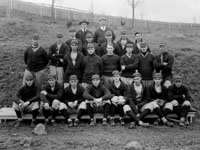 |
|
Near the turn of the century, the UVa baseball team (shown above) often faced major league players in town for training. Photo courtesy of UVa Small Special Collections Library. |
The Beaneaters Begin A Tradition
At the conclusion of the 1891 season, the American Association folded and many of the Reds players moved over to the rival National League’s Beaneaters. The Boston Beaneaters were baseball royalty, a charter member of the National League that played in the first game in the history of the league, defeating the Philadelphia Athletics 6-5. They would later become the Boston Braves, Milwaukee Braves, and then Atlanta Braves, and hold the title of being the oldest continuously playing team in American professional sports. With only one Boston team now vying for the rights to train in Charlottesville, the Beaneaters made plans to travel to UVa for the 1892 training season.
Boston’s trip to Charlottesville was not a surprise to baseball fans in the state. Their captain, Billy Nash, was born in Richmond two months after General Robert E. Lee surrendered his Confederate Army to Ulysses S. Grant in Appomattox. His prowess with the bat and ball led to an auspicious debut in professional baseball. Nash began his career in 1884 as a 19-year-old rookie with the Richmond Virginians of the brand new Eastern League, a minor league that later merged with two others to form the still-thriving Triple-A International League.
The Virginians had, as they say, “a cup of coffee in the big leagues,” when they were brought in midseason by the American Association to replace a team that had folded. Nash and the Richmond Virginians finished the 1884 season as true major leaguers before the AA contracted in the offseason, eliminating the Richmond contingent. Nash, though, leapt to the Boston Beaneaters, launching into a 15-year career in the major leagues.
Nash spent the 1890 season with the ill-fated Reds. His former teammate from the Virginians, John Powell, coached the UVa team that preseason, and lured Nash and the Reds to Charlottesville for spring training. Nash returned to the Beaneaters in 1891 and suggested that the team train in Charlottesville the following year. The Washington Post proclaimed, “Virginia is Billy Nash’s home and this arrangement suits him to a T. At Charlottesville the players will have the use of the grounds of the University of Virginia boys, and they will play three games with the college team.”
Nash, like many major league players and scouts, would also be hired to coach the University teams during spring training, which was a boon to the collegiate athletes. UVa’s baseball team in that era became one of the best in all of college sports. The team finished second to Yale in a prestigious tournament held in Chicago during the 1893 World’s Fair.
As Nash and Boston were becoming comfortable in their new home away from home, other teams took notice. The New York Gothams, later known as the New York Giants and today the San Francisco Giants, also played two games against UVa that Spring of 1892. New York returned again in 1895 for contests with UVa, as well as the Philadelphia Phillies who were jostling for room in Charlottesville the same preseason.
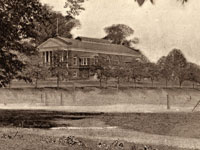 |
|
In 1897, Fayerweather Gymnasium was one of the premier facilities at UVa and beyond. Photo courtesy of UVa Small Special Collections Library. |
Crown Jewel Of The South Hosts Baseball Icons
Baseball was booming at Mr. Jefferson’s University. Part of the allure, without a doubt, was the crown jewel of the University sports complex, Fayerweather Gymnasium. Today Fayerweather Hall houses the McIntire Department of Art. But in 1893, it was the largest and best-equipped athletic facility in the South, featuring one of the longest indoor tracks in the country.
With the advent of today’s American League (not to be confused with the defunct American Association) in 1901, a new franchise was launched in Boston to compete with the Beaneaters. The rival “Americans” as they were called, spent their first moments together as a team riding awkwardly alongside their city’s counterparts, the Beaneaters, on the same train south for spring training. The Beaneaters split off in D.C. for Norfolk, while the Americans spent three weeks in Charlottesville that inaugural season. Rounding themselves into shape daily at the Mad Bowl field, these Boston Americans would begin one of the most famous baseball legacies in history, as they would later become the modern-day Boston Red Sox.
In 1901 the Boston Americans were led by Hall of Fame pitcher Cy Young, who would finish the year winning the pitching triple crown with 33 wins, a 1.62 ERA and 158 strikeouts. So, did the Cy Young spend three weeks training at UVa’s Mad Bowl? The Washington Post noted, “All the members of the team, except Cy Young, have engaged in practice here. Young, who has been getting in trim at the Hot Springs, will join the team in Baltimore.”
While some will lament this oh-so-close brush with perhaps the greatest pitcher in baseball history, Wahoo fans may be even more proud of this: The first game in the history of the modern-day Boston Red Sox organization, was a 13-0 victory against the University of Virginia. Yes, the Boston Red Sox, of Fenway Park and the Green Monster, that boasted such luminaries as the aforementioned Cy Young, Jimmie Foxx, Babe Ruth (who spent six years as a pitcher for Boston), Ted Williams, Carl Yastrzemski, Roger Clemens, Wade Boggs, and Pedro Martinez, kicked off their franchise by defeating the University of Virginia in a shutout on April 5, 1901 at Mad Bowl.
The Washington Post noted, “The Boston American League club played this afternoon, the first of a series of three games with the Virginia team. Capt. (Jimmy) Collins tried a trio of his new pitchers, Kane, Connor, and Mitchell, and the best the collegians could do was to get four hits, all being made off Kane. The (Americans) put up a faultless game in the field.”
Finishing their stay in Charlottesville on April 23rd, The Washington Post reported, “The Boston American League baseball team, which has been putting in some good practice on the Y.M.C.A. Campus at the University of Virginia since April 1, will leave here tomorrow afternoon for Baltimore, where the opening game will be played on Wednesday with the Orioles.” These Orioles, it should be noted, would later relocate and change their name to the New York Yankees.
Senators Grab The Bat(on)
In 1901, the upstart American League also heralded the birth of a new Washington franchise, the aforementioned Senators. After spending the first few springs of their existence training in D.C. or Hampton, Virginia, the club decided to visit Charlottesville in 1905. Garland Stahl played for the Boston Americans in 1903 and moved to the Senators in 1904, where he became a player-manager. It was likely Stahl who suggested that the team move to his old spring training grounds at UVa. In 1905, there were only 16 teams in the American and National Leagues, none farther south than Washington, D.C. or farther west than St. Louis, MO. So “heading south” to Charlottesville, with its supposed milder climate, seemed perfect.
That February, The Washington Post said, “The players will not only have a splendid field on which to practice, but in the event of inclement weather they will be enabled to do useful work in the well-equipped gymnasium in reducing weight, hardening the muscles, and working the soreness out of arms and legs. These are advantages that few, if any of the major league teams will have.” It was the start of a decade-long relationship that was both harmonious and plagued with troubles.
A Picture Perfect Scene
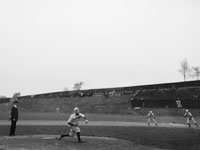 |
|
Lambeth Field provided the home diamond for UVa. Photo courtesy of UVa Small Special Collections Library. |
In their first year in Charlottesville, the Senators secured lodging at the Clermont Hotel (now the Starr Hill building on West Main Street) due to its proximity to the train station. For entertainment, the players attended the gymnastic tournament held at Fayerweather Gym. The Washington Post observed, “The men, especially the former collegians of the party, seemed to enjoy the ‘stunts’ of the embryo athletes on trapeze, flying rings, and mat.” All was well, and the facilities were viewed as the pinnacle of excellence. “Last night [Trainer] Quirk corralled the weary troupe of ball-tossers and gave them all a sea-salt bath and a thorough rubbing of the sore muscles. When the pitchers have had sufficient work he sends them around the track until the perspiration rolls off them. Then he takes them to the gymnasium for a good rub and shower bath. The weather has been so balmy and warm that the players have easily avoided catching colds, and this morning it was so warm that all hands laid aside their sweaters for the first time.”
A later report said, “It is probable that the local club (Washington) has a better training camp than any other club in either major league. The players have the advantage of splendid training quarters, a dry field on which to play, weather that is perfect, and a trainer who is doing the men a world of good. For three weeks they will practice every point of the game and have the additional benefit of playing the strong Virginia University team. Last year the only real work the boys got was in two games against Georgetown on a field that was damp and in an atmosphere that was raw and penetrating.”
This meet-cute between the Senators and Charlottesville was the start of a beautiful relationship. The prior season, Washington finished in last place in the American League at 38-113, the worst of both leagues. But hope springs eternal in baseball, and the Senators were ecstatic about their new training grounds. Finishing 64-87 in 1905, a 26-game improvement, the D.C. boys eyed Charlottesville as a magical elixir. To top it off, the trainer was delighted at hearing that a roller skating rink was in operation at Jefferson Park, two miles from the city. “On rainy days it will be the best exercise imaginable for the men,” he said.
But buried in the newspaper account of the 1905 training story was perhaps a foreshadowing of the perils that would await them, “Charley Jones, who got a nasty spill yesterday over the running track has not halted in the practice. His injured leg is healing, and gives him but little inconvenience.”
Former UVa baseball player Art Halstead, COL ’67, recalls a similar incident, “I played left field in Lambeth from 1965-67. Sure enough, I got tangled up with the cobblestone curb on the track on a line drive hit down the line, fell down, stuck my hand up and blindly snagged the ball to end the inning. [Our pitcher] Gammon was leading the nation in ERA at the time, so it was a big deal to make that play.”
Halstead elaborated on more of the hazards of playing at Lambeth Field:
“The outfield fanned out to be a real long shot to hit a home run as you went toward centerfield. A number of homers were hit to left center that plugged into the bank of the railroad track. From center field to mid-right field there was a cliff that went down to the spring football practice fields. There was always an argument about the ground rules about balls hit over the ridge being homeruns if they did not clear the edge in the air. Down the right field line was infinity.To the right of foul line were the track jumping pits. [Baseball] Coach Jim West and [track coach] Lou Onesty were great friends and competitive. One game a foul ball entered the track area out there. A trackman picked up the ball and threw it back to us and dislocated his shoulder in the act. They actually called out an ambulance to care for the guy. West did not let Onesty forget that.
We had a left fielder … on the first year team, aka the Cavayearlings. He ran back after a ball and tumbled over the fence into the briars beyond the fence. I can remember us being a player short for a few minutes until [he] made it back to the field covered with briars.
[But] I think that opposing players realized that Lambeth was a part of collegiate Americana and enjoyed playing there.”
A Major League Attraction
As much as the professional baseball team seemed to be enjoying Charlottesville, students and townspeople returned the admiration. In the spring of 1906, a large gathering of baseball enthusiasts met the team at the train station. The players took a short cut and escaped quickly to the Clermont, where they stayed once again.
Newspapers noted that during the evening several Virginia students stopped by the hotel to greet the players. One was Tom Thorpe, the ex-Columbia football star, who knew several members of the squad. Thorpe was the highly scrutinized transfer student from Columbia who was prohibited by President Alderman from playing football for UVa the previous semester until he could prove himself in the classroom. For Virginia fans familiar with Thorpe’s story, it is interesting to note that he stayed in school at UVa for the entire year, proving that he did not transfer merely for athletic reasons. For the duration of his time at the University, Thorpe never played football for the Cavaliers.
Another visitor was Frank Jackson, an African-American attendant at Fayerweather Gymnasium who gained local fame the previous spring by filling in as a utility man on the Senators second-string squad. Jackson came not only to pay his respects, but also to apply for a fielding position on the reserve squad again.
Before the Negro Leagues began in the 1920s, this was one of the rare opportunities for blacks to play with major league talent. The professional leagues unofficially banned African-Americans beginning in the 1890s and would not integrate until Jackie Robinson broke the color barrier in 1947. While Jackson would never have been allowed to be an official member of the Senators’ team, they did in fact have two Cuban players on the squad in later years. Merito Acosta played for Washington and the Philadelphia Athletics between 1913-1918, and Jack Calvo spent parts of 1913 and 1920 with the Washington team.
Despite the successful marriage between the Senators and Charlottesville, their partnership would take a hiatus beginning in 1907, when new manager Joe Cantillon replaced Stahl. Cantillon took the team to Galveston, Texas, for spring training for several years, before he was fired after three seasons and a .347 winning percentage. The highlight of his tenure, however, was the discovery of a pitcher who was one of the best in the history of the American League. In 1907, 19-year-old Walter “Big Train” Johnson arrived and threw the ball faster than anyone had ever seen.
Clark Griffith Visits for First Time
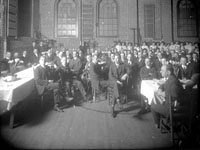 |
|
Fayerweather Gymnasium was an “ideal gym for indoor work” during spring training. Photo courtesy of UVa Small Special Collections Library. |
In 1912, when Clark Griffith took the reins as both manager and part owner of the Senators, he was determined to turn things around. Having heard of the success of the training camps in Charlottesville in prior years, he visited UVa in January 1912 in the company of Trainer Mike Martin. Griffith surveyed Fayerweather Gymnasium and, according to The Washington Post, offered this assessment: “It looks to be an ideal gym for indoor work. There is a large net which covers the entire space and a canvas screen at each end of the hall. The net and screens keep the ball in the space, and it will be here that the pitchers and catchers will work out on bad days. There are plenty of shower baths and lockers for the players.”
After deciding on Fayerweather, the group visited Lambeth Field, joined by Athletic Director William Lambeth. The Washington Post beat writer said the contingent, “looked over Virginia’s diamond, the best college field that the writer has ever seen. It is an ideal spot. The infield has been prepared by Umpire Rigler, being composed of a special combination of clay and very fine ashes. It has been harrowed, and all that is needed now is the roller. The drainage is perfect, and Rigler says that it can rain in the morning and in the afternoon the field will be ready for play. The whole field is as level as a billiard table, the outer garden especially being in fine shape.”
The article continued, “Griffith expressed himself very much pleased with the grounds, and had a complimentary word for the cement stand now nearing completion, the first unit in the stadium which, when complete, will accommodate 8,000 people.”
Nearing completion at Lambeth Field was the new concourse and colonnades that would be christened “Lambeth Stadium” the following year. The theater-style venue would also include two clubhouses on either end for both the home and visiting teams in football, baseball, lacrosse, and track. Sportswriters, fans, and athletes agreed it was the largest and most luxurious outdoor athletic facility in the entire South. The cluster of Fayerweather Gymnasium, the YMCA Campus, and Lambeth Stadium created an athletic complex that rivaled any sports city of its time.
Home Sweet Home
In addition to being enthusiastic about the fine facilities that UVa’s Grounds had to offer, Griffith also was excited about the sleeping and dining arrangements. The Washington Post noted, “Later in the afternoon the Washington manager succeeded in renting suitable quarters for the members of his squad during their stay here. An eighteen-room dwelling, formerly occupied as a fraternity house, was secured, and the players will all be put under one roof and compose a happy little family. The large dining room of the building will be converted into a parlor, where the players can find amusement of evenings without having to look for it elsewhere. A piano will be installed, and everything made as comfortable and homelike as possible.” Griffith was insistent that his players sleep in one location; the large fraternity houses on and around Rugby Road provided just that.
Other clubs took notice of Griffith’s spring training trip strategy; The Sporting Life reported that other franchises were beginning to take up the same plan. Griffith wanted efficiency in all matters, so the players would eat their meals next door at the best boarding house in town. He dictated the menus, too, which included steaks, roasts, and other delicacies delivered from Washington. As Charlottesville was one of the early adopters of Prohibition, which at that time was determined by localities and not yet by the federal government, Griffith was sure his players would get the best nutrition and stay clear of alcohol and tobacco.
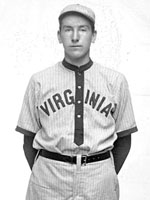 |
|
Eppa Rixey emerged as a pitching star at Virginia and in the pros. Photo courtesy of UVa Small Special Collections Library. |
Eppa Rixey
With its facilities, living accommodations, and excellent collegiate competition, the University of Virginia seemed to offer everything in a spring training destination. Adding to an embarrassment of riches, the school also boasted one of the best pitchers in the college ranks. Eppa Rixey Jr. was the ace of the Virginia pitching staff, throwing several no-hitters during his first three seasons. He also lettered in basketball, where he used his 6’5″ height advantage to dominate opponents.
Griffith met with Rixey in January 1912 when the UVa basketball team traveled to D.C. to take on Georgetown. Rixey was courted by other teams, but he agreed to give Griffith the first chance to sign him, although he preferred to graduate and instead become a chemist. Griffith was excited to size up Rixey during spring training in Charlottesville, as the ace hurler would pitch one or two games against the professionals.
The Senators Return
When this new era of Senators’ spring training in Charlottesville officially kicked off in March 1912, the first signs of trouble arose – or, more accurately, fell. The Washington Post alerted their readers, “It was a tired and hungry clan of ball players and scribes that reached Charlottesville late this afternoon, and to make matters worse, a driving northwestern snow storm greeted the party as they alighted from the train. The downy flakes started falling a few minutes before the train reached its destination, and it is safe to say the players will not be able to have their first outdoor workout for at least two days. At a late hour tonight the snow was still falling.”
Fortunately, students took to entertaining their guests. “The boys will be entertained Saturday by talent from the University of Virginia. Albert Stern, the amateur baseball editor of the Post and a student here, is prime mover in the entertainment. It is planned to have the Glee Club render selections. George Waller and Kirk Payne, female impersonators, will also take part in the entertainment.”
But the bad weather persisted. The Washington Post beat reporter lamented, “This is no place to send a baseball reporter. What should have come was a writer of storm stories. Apparently the only time it doesn’t rain hard in Charlottesville is when it is raining harder. And if by chance neither condition obtains for a brief period, snow is falling, or this is a dull, gray hour in which the storm king is meditating as to which of his minions he shall send to interfere with plans.”
Rixey Dazzles
Eventually, the snow melted and baseball was on once again. The Sporting Life spread the news of Eppa Rixey’s dazzling debut against the professionals: “The collegians won the first contest, 5-3. Southpaw Eppa Rixey pitched six innings for the University and struck out six, allowing no runs and only three hits. He was the only one who got much glory out of the contest. The Washingtons won the second game, 11-1. There was no Rixey to contend with, and three Virginia twirlers were maltreated by Griffith’s clubbers.”
Rixey was an interesting character. While many ballplayers of the era came from rural and farming backgrounds, Eppa’s father was a banker while one uncle, John Rixey, was a congressman, and another, Presley Rixey, was the Surgeon General of the Navy. Rixey’s family moved to Charlottesville, where he attended high school and then entered the University, earning his bachelor’s degree in chemistry. Wanting to springboard into a career as a chemist, Rixey had leverage when it came to deciding whether to play professional baseball or begin his life as a scientist.
While he offered Griffith the first opportunity to acquire his services, National League umpire Cy Rigler, who moonlighted as UVa’s baseball coach from 1910-12, persuaded Rixey to consider the Philadelphia Phillies. After graduating in the spring of 1912, Rixey started his professional career with the Philadelphia team, going 10-10 with a 2.50 ERA.
Rixey then returned to UVa in order to get his Master’s Degree in chemistry, which did not please the Phillies who wanted him to train with the team in the spring of 1913. The Washington Post quoted the Wahoo graduate student as saying, “If the Phillies want my services this year, they will have to accede to my demands for more money and allow me to complete my course at college. I am going to complete my work at the University of Virginia, remaining at Charlottesville until June. Of course I will be ready to work immediately after reporting, as I expect to work right through the season with the Virginia squad.”
Rixey’s demands were ultimately met in late April, and the hurler did leave before graduation. He went on to set the National League record for wins by a left-hander with 266 until Warren Spahn broke it in 1959. Rixey split his time in the major leagues between Philadelphia and the Cincinnati Reds, where he was traded for Greasy Neale in 1921. Neale had led the Reds in hitting percentage during the 1919 World Series, which was marred by the “Black Sox” scandal. With Neale traded back to the Reds in 1922, he and Rixey struck up a friendship that included both being tracked across Cincinnati by Prohibition agents as the two visited speakeasies. It was perhaps during this time, while imbibing illicit beverages, that Neale heard Rixey’s tales of the University of Virginia. Neale would become the head football coach at Rixey’s alma mater the following year – while still continuing to play for the Reds during the spring and summer.
Rixey played 21 seasons in the pros, retiring at age 42 in 1933. He was elected to the Baseball Hall of Fame in Cooperstown in 1963 and was the first Virginian to achieve this honor.
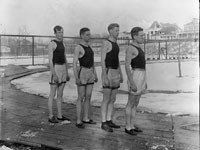 |
|
Snow sometimes interrupted outdoor training. Photo courtesy of UVa Small Special Collections Library. |
Let It Snow, Let It Snow
During Clark Griffith’s first visit to Charlottesville, the Washington Senators continued to feel the effects of the unpredictable weather. The Washington Post lamented the conditions but also championed the uniqueness of Lambeth Field, “Manager Griffith’s plans for a driving finish were checked temporarily today, the weather man cutting in and the team being fortunate in that it was able to get on the field at all. In the afternoon there was a workout on the field that is the king of all college diamonds in recuperating after too great indulgence in liquids.”
With the bad weather came offers from other locales for Griffith to consider for spring training. As both an owner and manager of the team, Griffith had a unique perspective and a brilliant baseball mind. From the moment he joined the Senators, he changed the culture of the organization. He reached out to community members by joining civic associations and added more ticket booths across D.C. to create more accessibility for fans. He replied to each and every complaint letter that was received, where his predecessors usually threw them in a wastebasket. He was prudent and practical, a shrewd negotiator, but one who was also willing to add smart amenities to his home stadium, like additional exits to improve foot traffic.
When it came to spring training, Griffith strove to find the best possible location at a reasonable cost. Raleigh, NC, came on strong with a pitch for the 1913 training season. Anniston, AL, did, too, even offering exclusive use of a hotel that would construct a special locker room and set of showers in its basement for the Senators’ use. This sparked an idea in Griffith’s mind that was revolutionary for the time: Why not own your own spring training ground?
The March 6, 1912 Washington Post announced, “If present plans of Manager Griffith do no go amiss, the Nationals will train at Raleigh, N.C. next season. It is Griffith’s intention to build a permanent home for the Nationals, something on the order of the one they now occupy. If suitable grounds can be secured, the Washington club will also own its own ball park. This will do away with the bother each year of selecting a training camp. Arrangements here are so satisfactory that Griffith has practically decided on this plan.”
No Room At The Inn
Upon hearing this, the University launched full throttle into making its guests feel as welcome as possible. The athletic department at UVa began discussing future plans and how to keep Griffith and the Senators coming to Charlottesville. There was no need to convince him of the quality of the facilities. His main issue was the living arrangements and meals. The boarding house and sleeping quarters the Senators first enjoyed were no longer available after the 1912 season, as both had been bought by private families. “Mrs. Saunders,” as The Washington Post called the proprietress of the boarding house that fed the players, had moved to Chancellor Street, right in the midst of several fraternity houses.
By December 1912, Griffith had received proposals from nine towns to entertain the Senators during spring training. The Washington Post announced the heated race: “[Griffith] doesn’t like a complete change of climate … and doesn’t believe in a lot of foolish and unnecessary expense in the way of railroad and Pullman tolls. Charlottesville is the place for which Griffith really pines. The weather is good and there are no sea breezes, while the presence of the University of Virginia, with its gym and its ball team, is a further advantage. It is expected that Charlottesville will awaken to its peril in a few days, when it learns how great effort is being made by other towns to secure the Nationals, and how much advertising it may lose.”
Fraternizing
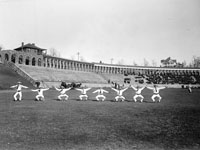 |
|
The Lambeth Field stadium seating and The Colonnades made the facility even more attractive. Photo courtesy of UVa Small Special Collections Library. |
By January 1913 Griffith had found the solution. The Sporting Life revealed, “Manager Griffith has settled upon Charlottesville, Va., as the Senators training place. The deal was made possible by the Delta Chi Fraternity of the University of Virginia giving up its fraternity house to the Washington players for one month.” Delta Chi was, and still is, perched on the street directly overlooking Lambeth Field. In addition, improvements were being completed on Lambeth Field. The wooden grandstand had been torn down and the concrete stadium was almost complete. The athletic field had been enlarged, which now included a lower level for additional training space; this is the area where Lambeth Dorms now stand).
While facilities continued to improve, one issue still needed to be addressed: There was no heat in the dressing rooms at Fayerweather Gym. The players felt it was colder inside than out. Griffith, it was said, would do what was necessary to ensure his players’ comfort.
College Topics, the UVa student newspaper at the time, quoted Griffith as saying, “Before we leave, I hope to make some arrangements with the University authorities that will allow us to establish a permanent training camp here. Lambeth field is ideal for training purposes. It is not only an excellent playing field, but it possesses the unusual advantages of perfect drainage, allowing us to use it in a very short time after rain.” Griffith already had begun making Lambeth his home away from home, going as far as importing canvas covers to be placed on home plate and the pitcher’s mound to protect them during rain and snowstorms.
The Washington players also had grown fond of Charlottesville. They made many friends and, according to townspeople, had gained respect for the town and the University by the way they were treated.
Walter Johnson, meanwhile, entertained fans even when not playing in a game against the Wahoos. “Interest in the onlookers centered on Walter Johnson. A number of native residents, who had come over to the field to see a real game, forgot their sorrows when the big fellow trotted out and proceeded to lambaste Eddie Ainsmith’s big mit with his assortment of shoots,” The Washington Post reported.
Johnson, since joining the Senators as a rookie in 1907, had a below average pitching record, going 32-48 through 1909. But in the two years prior to the Senators’ return to Charlottesville, the “Big Train” won 25 games in back-to-back seasons with 313 strikeouts in 1910 alone. In the first two seasons after the Senators’ return, he won 33 and 36 games. Johnson played his entire 21-year career with Washington, earning several pitching records. He held the all-time strikeout crown with 3,509 for 55 years and is still the record-holder for career shutouts with 110.
Ty Cobb was amazed by Johnson’s power pitching: “The first time I faced him, I watched him take that easy windup. And then something went past me that made me flinch. The thing just hissed with danger. We couldn’t touch him … every one of us knew we’d met the most powerful arm ever turned loose in a ball park.” That speed helped Johnson win 417 games, still second most in history to Cy Young’s 511.
Spring Rings Anew
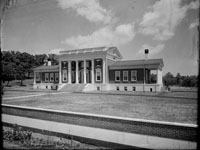 |
|
The YMCA athletics campus (now Madison Hall) provided additional training ground. Photo courtesy of UVa Small Special Collections Library. |
At the conclusion of their 1913 spring training, the lovefest between the two parties was at an all-time high. The Senators’ organization felt it was the most successful in franchise history. Griffith made plans for 1914 almost immediately, securing the Kappa Alpha house for lodging and Mrs. Saunders’ boarding house for meals. William Lambeth assured Griffith that the faculty and student body would be glad to have the team as their guests again, too.
Lambeth Stadium was now complete, and the new pavilions on either end of the colonnades would alleviate congestion at Fayerweather Gym, where the Senators had to share the locker rooms with the students.
When it came to the weather, the Washington organization’s feeling was that it was best to train in a climate similar to that of its home city. The organization wanted to avoid training in too warm of a locale, as it was thought that a sudden change of temperature when returning to blustery D.C. in early April would shock the players’ systems.
In that same offseason, Griffith proved once again that he was a radical thinker, careful with his money but willing to splurge when he thought the idea worthy. In February 1914 he offered Ty Cobb of the Detroit Tigers $100,000 to play for the Senators. And Griffith was even willing to spend his own money if necessary to do it. Cobb set 90 major league records during his career, and the Nationals needed that kind of firepower. While Cobb declined, Griffith had displayed his trailblazing tactics yet again.
But as wonderful as the weather was for the Senators in the spring of 1913, it was the exact opposite in 1914. “More fickle weather could not be found in any part of the globe,” The Washington Post complained. “Why train at Charlottesville another year? The players are thoroughly disgusted. The team will have been here one month. To date five days’ good outdoor work has been accomplished. According to newspaper accounts the majority of other teams have experienced ideal training weather, and are pretty near fit to open the season. Southward ho, in 1915, is the players’ slogan.” At one point, more than 19 inches of snow fell in Charlottesville. Griffith paid for Lambeth field to be cleared five times.
Offers were now coming in from Cuba for a potential training site. But Griffith was steadfast. He felt that 1914 was an outlier and the D.C. club would not encounter similar weather in future seasons. He felt that every training camp, no matter where it was held, was a gamble, and this year he’d lost. The Senators worked out feverishly in the comfort of Fayerweather Gymnasium, intermittently treated to collegiate basketball games between UVa and visiting teams.
To the surprise of many, the Senators had an improved season in 1914. They finished third in the American League, and Walter Johnson led the majors with 28 wins and 225 strikeouts, while Washington’s Dutch Leonard led both leagues with a 0.96 ERA.
The next spring, the weather reverted to its 1913 form. Only two days were lost outside in 1915 due to weather conditions. Griffith was pleased with the well-oiled spring training machine he had created. Even hiccups with lodging didn’t seem to faze him; conversely, it allowed him to flex his negotiating muscles. In 1916 the Kappa Alpha fraternity on University Circle, where the Senators had stayed in 1914 and 1915, refused to abandon its house for three weeks for Griffith’s men to invade it yet again.
Griffith visited the Kappa Sigma fraternity on Rugby Road in January of 1916 to work out a deal with it instead. It was halfway between Fayerweather Gym and Lambeth Field, a perfect location. After enjoying lunch at Mrs. Saunders’ boarding house, he also visited Preston Heights to show that there was competition for his business. Upon returning to Kappa Sigma, Griffith began negotiating with the fraternity president, Gene “Buck” Mayer. Mayer was voted the South’s first All-American football player just one month prior, leading UVa to a 23-3 record his last three years there and the first victory over Yale by any southern team.
Griffith raised his offer by $100, but the Kappa Sigma boys declined, as it would have forced them to take shelter elsewhere during the middle of their exams. Instead, after hearing of the increased offer, Kappa Alpha leapt back into the discussion and offered its house yet again. With it adjoining the boarding house that Mrs. Saunders now ran, it was the perfect scenario for Griffith … just like he planned.
Pleased that accommodations had been secured for his guests, William Lambeth took Griffith on a tour of another impending improvement to UVa’s facilities. The Washington Post noted, “When Griffith was down yesterday he was taken over to the site of the new athletic clubhouse, the excavation of which will be completed this week. The new structure, which is to be located on the eminence above Lambeth field, is to cost $30,000 and will contain a large swimming pool.”
With the YMCA campus, Fayerweather Gymnasium, Lambeth Field, and now Lambeth Stadium, the University of Virginia had stayed in the forefront of the facilities arms race between southern schools. A new athletic facility was already being excavated, and Griffith wanted to be in on it. A plan was under consideration that stated the Senators would pay, through a lease, for the construction of an additional wing that would contain living quarters for the players each spring. To live and train in the same state-of-the-art facility, right above the diamond on Lambeth Field, would revolutionize the world of major league spring training.
It was a beautiful plan, except for one thing: World War I. With the United States’ entry into the conflict in 1917, work on this new sports megaplex was put on the back burner. In fact, the University’s centennial anniversary was also postponed for two years “because of disturbed world conditions following the Great War,” said John Stewart Bryan, rector of the University. By the time the UVa officials resumed discussions of the proposed clubhouse at the end of WWI, their thinking had changed. Donations were now being collected for the construction of an even grander athletic facility, one that would be a memorial to the 2,700 students and alumni killed in the war. In 1921 plans were designed for the new Memorial Gymnasium, which upon completion would be the third-largest gymnasium in the entire eastern United States.
With the Lambeth clubhouse off the table and even more snow during the 1916 Spring Training session, Griffith became open to the possibility of other locales for the Senators. “It snowed early this morning for a few moments, stopped, and then began again,” reported The Washington Post. “Coming out of the gymnasium they were greeted by one of the severest snowstorms that has visited Charlottesville in years.”
Charlottesville and the University of Virginia, for all its charms, its proximity, and it facilities, was now looked upon differently. Despite Griffith’s loyalty to this “Virginia hamlet,” as he called it, his mind was always working, always pushing the envelope to make his organization the best it could be. Just three years prior, in 1913, the Chicago Cubs and Cleveland Indians trained in Tampa and Pensacola, respectively, where the weather was milder and more predictable. The next year, two more teams joined them for what is considered the start of the Grapefruit League. Great weather and major league competition: just what the doctor ordered.
From 1917-1919, Griffith took the Senators to Georgia before finally settling on Tampa from 1920-1929. Griffith, a creature of habit, was thrilled with the warm, temperate climate. But, like his time in Charlottesville, it did not last. While there was no snow to contend with, the “debilitating sunshine of Tampa,” as The Washington Post called it, was not suitable. His players baked in the hot sun. Perhaps some longed for the beautiful spring days on Lambeth Field at the University of Virginia, despite the occasional interruptions by the Storm King. But this was a new era. Spring training rarely took place north of Atlanta anymore. So, Griffith gathered his troops in 1930 and boarded a train for yet another greener pasture. Next stop, Biloxi!
About The Author: Kevin Edds is the Writer/Director of the documentary Wahoowa: The History of Virginia Cavalier Football. For more information on the film, please visit www.UVaFootballHistory.com. TheSabre.com periodically features articles on the history of UVa football where Edds, an alumnus, highlights some of the most interesting moments in the more than 120-year history of the South’s oldest football program. Email Kevin here.
Wahoowa: The History of Virginia Cavalier Football |
|

|
|



